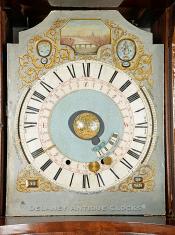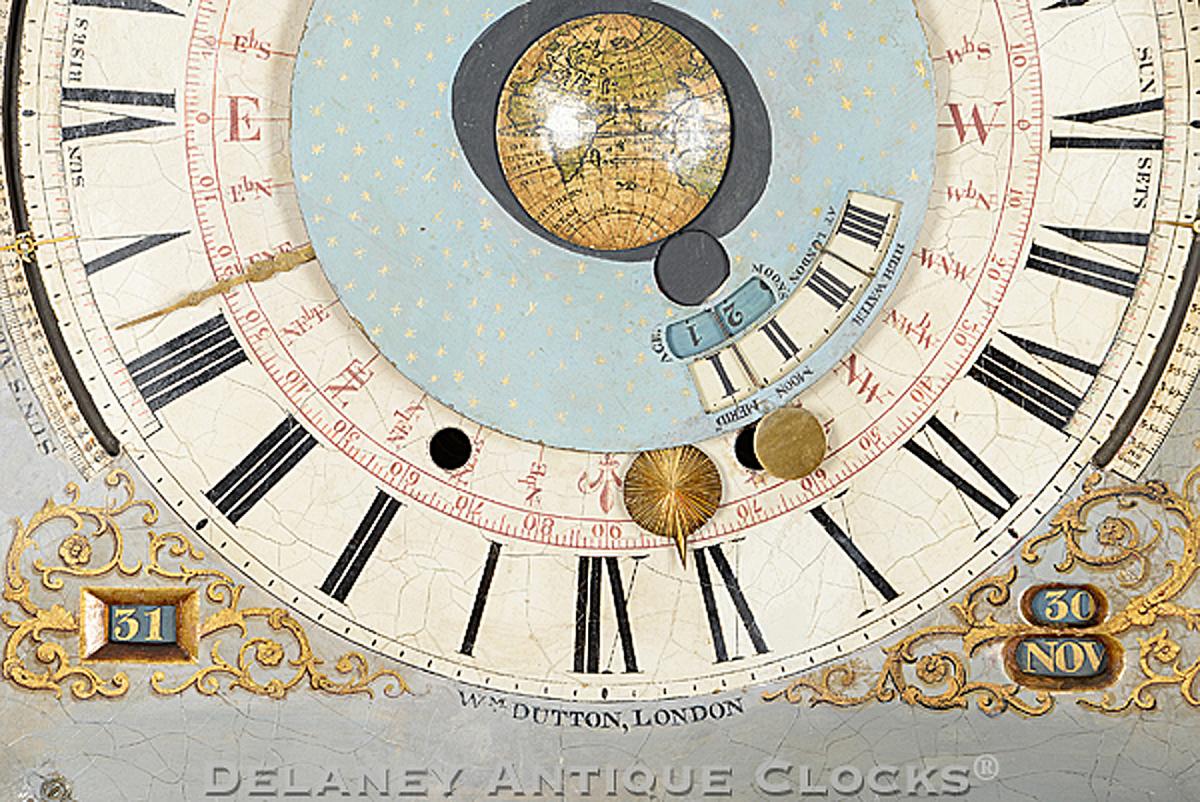William Dutton of London, England. A complicated tall clock with wheelwork fabricated by James Ferguson. VV-31.
This is an outstanding mahogany-cased tall clock with a dial that features multiple complications made by William Dutton of London. William Dutton served his apprenticeship under Master Clockmaker George Graham in London. For a short time, he partnered with Thomas Mudge. Dutton was a very competent Maker.
Here is a list of the clock's complications:
- The movement is a two-train design. It strikes the hours on a single large bell.
- It is an eight-day clock powered by two drive weights.
Dial functions or displays.
The painted dial features a 24-hour display. The hours are presented in Roman-style figures. The minutes are graduated between the hours. A single brass hand displays the time.
The brass engraved disk references the sun's position in the sky.
The moon disk, also brass but polished flat, shows the moon's position relative to the sun.
The two displays positioned on either side of the time ring show the following representations.
On the left, the side shutter calculates the sunrise and sun's meridian altitude.
On the right, the side shutter displays the time of sunset and the length of twilight.
Tidal functions.
The rise & fall of the tide is visually depicted in the arch. The center city view of London and the Thames River is skillfully painted. A painted shutter moves up and down from the lower section of this scene. This is a representation of the tide level.
Lunar Functions.
We mentioned the brass globe in the time section. The inset disk located below the representation of the painted globe displays the phase of the moon in the window.
Below this is a display for the MOON'S AGE. This is a numerical display.
Calendar functions.
The month, bottom right, and the day of the month, bottom left window are presented. The window above the month displays the current date.
The Zodiac symbol and the number of days in that constellation are depicted in the upper left corner of the dial.
The upper right corner displays the current day of the week. Above this is a representation of the Deity symbol for that day.
The Time Ring.
There are four dial rings. From the outside in, there is a dotted minute ring, hour ring, declination of the moon, and a compass.
This unusual mahogany clock case measures an impressive 89.75 tall.
Inventory Number VV-31.
William Dutton is thought to have been born in 1720 and served his apprenticeship under the famous George Graham of London in 1738. He completed his apprenticeship in 1746 when he became a Freeman of the Worshipful Company of Clockmakers. In circa 1750, he became a partner to the famous Thomas Mudge, another apprentice of George Graham. Their business was located at No. 148 Fleet Street, London. T his address was used by the Dutton family for several generations. William and Thomas Mudge were two of the developers of the Lever Escapement for use in watches. In 1771, William took over Mudge's company when Thomas moved to Plymouth. William entered the Livery of the Worshipful Company of Clockmakers in 1766. About 1775, William took his sons into partnership and they traded under the firm name of W. Dutton & Sons, London, as well as still trading as Dutton & Mudge. The partnership with Thomas Mudge was not dissolved until 1790, and the Dutton & Mudge name still appeared on items until Mudge's death. William and Thomas Mudge both died in 1794. William had two sons, Matthew and Thomas.










